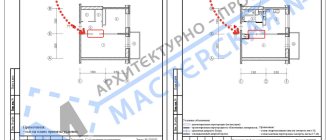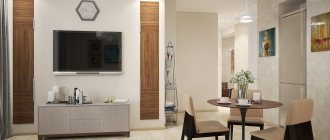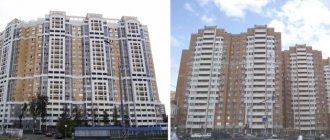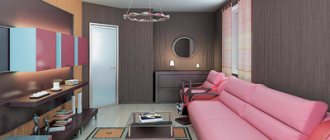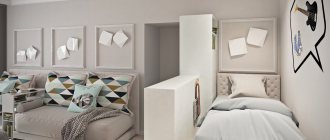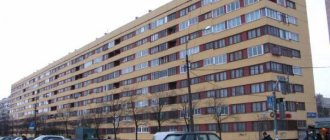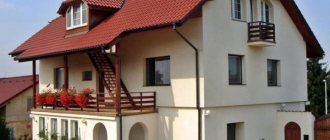Five-story old buildings are not particularly comfortable. At one time, they were built quickly and with the task of providing families with separate housing. However, no one in those years set the goal of comfort and convenience. Projects were done quickly, and buildings were erected even faster. Today, many versions of three-room Khrushchev apartments are so outdated that they require redevelopment.
Old five-story Khrushchev buildings do not at all correspond to modern ideas about comfortable housing
Restrictions on redevelopment and repairs
The redevelopment of the apartment takes place in several stages. First, a project is being developed for the redevelopment of a Khrushchev-era building in a 3-room apartment. It makes sense to entrust this work to specialists - they will perform the necessary calculations, make the necessary drawings and conclusions for them, and also present them in the best possible way to government agencies.
The traditional interior of Khrushchev is small rooms with low ceilings that constantly put pressure on your head
If the redevelopment has already been carried out, then specialists will carry out the necessary measurements and calculations, and analyze the apartment for violations. If there are no violations, then you can submit documents to legalize alterations in the apartment. If any violations do occur, they must be eliminated. It is better to do this before they are discovered by regulatory authorities.
Children's
The room for my son is designed in neutral warm gray tones. The interior can be changed as the boy grows up, adding color accents.
White shelves designed for books are child-friendly because they show off the covers rather than the spines. A small sofa folds out and serves as an additional place to sleep.
The house-shaped bed is equipped with drawers for storing toys - this technique significantly saves space in a small room.
Limitations in the redevelopment of a three-room Khrushchev house
The legislation provides for a closed list of prohibitions on changes in the design of apartments. In the apartment under no circumstances is it possible to:
- Touch, destroy or alter load-bearing walls.
- Violate the integrity of the plumbing cabin.
- Rearrange water and sewer lines.
- Move the gas stove to another room.
- Change the location of sinks, bathtubs, toilets and other water-related equipment.
- Move the “wet” area to another location.
- Attach a balcony or loggia to permanent premises.
- Move heating appliances to a balcony or loggia.
- Carry out other work that may compromise the integrity of the building or affect the quality of life in other apartments.
Changes that are not prohibited, but require mandatory approval, include:
- Change of any engineering communications.
- Insulation of the facade of the house.
- Changing internal wall structures.
- Demolition of walls inside the apartment.
- Construction of walls inside the apartment.
- Replacing a bath with a shower.
- Changing the wall opening.
After the project is completed, the stage of coordination with the BTI begins. To do this, you need to pay the state fee and submit all documents to the Housing Inspectorate or another body that deals with the approval of redevelopments. During redevelopment, all changes are also made to the technical passport of the apartment and to the BTI plan.
Documents required for redevelopment of a 3-room Khrushchev house:
- Project of the premises.
- Statement.
- Technical certificate.
- Certificate of ownership.
- Extract from the house register.
- Certificate of absence of debt.
- Certificates from the SES or the Ministry of Emergency Situations, if necessary.
After the documents have been submitted, all that remains is to wait for the decision of the housing inspection. Typically this period is 1 month, but it can be extended to 2 months if the inspection has questions about the project. The complexity and timing of obtaining approval documents for a panel or brick house is no different.
Description
Unlike other “panels”, the P-30 project was not widely used, although it was used for the construction of residential buildings for quite a long time - from 1971 to 2005 (with minor variations of the series).
The series of houses were mainly built in the capital and, less frequently, in other cities of the Russian Federation. Visually, the houses in this series are easily distinguished by their loggias, which are “recessed” into the facade. In addition, in some modifications of the project, loggias were made at the ends, and each house in the series had a special extension on the ground floor level, where retail space was supposed to be located. After 2010, major renovations of P-30 houses began in the capital; houses of this series were not included in the list of buildings subject to demolition.
Examples of the layout of a three-room Khrushchev apartment of different sizes
There are a lot of options for redevelopment in 3 rooms of a Khrushchev building. Here you can combine rooms, making the space wider, and place them along one corridor, and even increase the number of rooms to 4.
Option for redevelopment of a Khrushchev-three ruble apartment into a four-room apartment
The number of rooms is increased to 4, usually in large apartments with an area of 58 square meters or more. Often a small room becomes a storage room, provided that it has a window.
In apartments of about 54 square meters, on the contrary, they usually combine one room and a kitchen. Or they remove the door between them, widening the doorway and installing an arch in it.
At the same time, redevelopment of the home primarily depends on the number of family members, their age, gender and even occupation. Usually, all members decide on the number of rooms and their location at a family council, distributing who and how it will be convenient to live here.
How to increase space?
Even if you don’t plan to demolish the walls, you can really increase the usable area of the three-ruble ruble by wisely managing the available territory:
- avoid unnecessary details of the situation, do not clutter up your home. Any item used in the design of an apartment must be functional;
- focus on height: cabinets rising upward, proper arrangement of furniture, proper lighting;
- hang mirrors, place transparent glass surfaces;
- The pantry can be turned into a convenient dressing room by installing shelves, hangers, and a chest of drawers for storing small items. A dressing room will be an excellent replacement for a closet, allowing you to significantly save space;
- a loggia or balcony can become a work office, a cozy nook for tea or a miniature gym. It is necessary to insulate the loggia or balcony so that it can be used all year round;
- Instead of ordinary swing doors, it is better to install sliding doors or accordion doors. This allows you to win up to 1 m2;
- lighting should be bright and abundant. Instead of one massive chandelier, use several spotlights. Methods for their location can be easily found in photos on the Internet. Well-lit rooms always look more spacious.
Features of three-room Khrushchev apartments
Three-room Khrushchev apartments have a number of inconvenient features that you really want to correct with the help of a major overhaul.
Transforming a small apartment into comfortable housing is possible if you carefully consider every meter of space
Disadvantages:
- Low ceiling height.
- Narrow long corridors in panel houses.
- Unjustifiably wide hallways in brick Khrushchev buildings.
- Adjacent walk-through rooms.
- Thin walls and poor sound insulation.
- Inconvenient bathrooms.
- Small cramped rooms.
- Limited kitchen space.
Such problems are easily solved by changes in the design of the apartment. The height of the ceilings, of course, cannot be changed with the help of redevelopment. However, you can change the design of walls and rooms, which will visually add space.
Good lighting in combination with light colors visually expands the space
Narrow corridors can be expanded by rearranging walls or changing the layout of rooms. On the contrary, large, voluminous hallways should be reduced and their area given over to living rooms.
In this case, you can change both the location of the rooms themselves and their sizes. So it makes sense to make remote rooms more intimate, and those closer to the entrance more spacious.
Choosing a floor covering
The flooring should be given special attention. Often, the original floors in Khrushchev apartments are made of wooden boards, the service life of which does not exceed 20-30 years. That is why during major repairs and redevelopment it is impossible to do without removing the wooden covering and screed. This is especially true for those rooms where laminate or linoleum is planned to be laid. In rooms where it is planned to use tiles as a floor covering, leveling the surface is not necessary.
The best choice of flooring for a 3-room apartment is tiles. In the case where the combination of three rooms results in a studio, there is a need for zoning. As you can see in the photo, a multi-level floor with a different coating looks original. The walls are painted in different colors, the result is a spacious, stylishly decorated, convenient and comfortable apartment. The walls of the non-working space are decorated using decorative plaster.
Options for the arrangement of rooms in a three-room Khrushchev house
When developing premises layout plans, it is important to take into account the lifestyle of all family members and analyze their main movements around the apartment. Perhaps all the residents get up early and also go to work in the offices together early, and then return home at about the same time. In this case, you should think about a wide corridor and a separate bathroom.
You can visually expand the corridor using light wall decoration or through redevelopment by moving the partition between the hallway and the living room
Replacing a bulky bathtub with a compact shower will solve the problem of saving space in a small bathroom
Maybe, on the contrary, all residents have different schedules - young people work remotely at home in their rooms, wake up late, only one adult wakes up early and immediately goes to work, and an elderly grandmother is constantly busy with housework. Here it makes sense to expand the kitchen at the expense of the adjacent room and make a beautiful dining room.
To divide the kitchen-living room into zones, a bar counter is often used
Popular room layout options:
- By tram.
- A vest.
- Mini improvement.
- A book.
A tram is an elongated layout where all the rooms and passages to them are attached to one another. This arrangement is considered very inconvenient. Here only the very last room becomes an isolated space. The kitchen can usually be accessed through the hallway, the living room through the kitchen, and other rooms through the living room. It turns out that each time you need to go through the entire apartment in a row. This inconvenience can be corrected by placing all the rooms along one corridor. You can also combine the living room with the kitchen, which will add more space to the apartment.
Layout of a three-room Khrushchev house “tram”
The layout with a vest is considered the most successful. With a vest, the corridor is in the center of the apartment, and rooms are located on opposite sides of it. Thus, all rooms are isolated from each other and face different sides of the world. Different lighting in the rooms makes the apartment more cozy and psychologically comfortable. The disadvantages of such layouts may be unreasonably large corridors, due to which you can increase the space of the rooms. Often, such apartments still have small, uncomfortable kitchenettes. This problem can again be solved by combining the kitchen with the nearest room.
Layout of a three-room Khrushchev “vest”
From the point of view of Feng Shui, this arrangement is not very good, since here the corridor becomes the central room - that is, the passage space. To balance the arrangement of zones, it makes sense to enlarge one room and make it central. This could be the living room, dining room or living space of the head of the family. Thus, energy will be concentrated in this area.
The book layout assumes the presence of two adjacent rooms. They can only be separated by rearranging the corridor, but in this case it will turn out to be quite narrow. But if you choose between isolation and a narrow corridor, then from the point of view of psychological comfort it is better to leave the corridor.
Layout of a three-room Khrushchev house “in a book”
The mini-improvement layout is the most harmonious placement of rooms around a hallway. At the same time, he can have his own pantry.
“Mini-improved apartment” - the most convenient layout of a three-room Khrushchev house
This arrangement provides the greatest space for creativity when renovating. You can even add one room to this apartment if the number of windows allows. You can also combine the kitchen and living room, or reduce the corridor itself.
Everything must be legal
When planning a major renovation, consult with experts. They will tell you what changes can be made and what changes are strictly prohibited.
When drawing up a project, you must consider:
- in some cases, dismantling walls may be prohibited;
- any change in the configuration of the walls must be agreed upon and registered;
- you cannot move the bathroom, as this can damage the sewerage system in the entire multi-story building;
- If you have a gas stove, combining the kitchen and living room is prohibited. Install an electric stove or use a light partition.
To create a project, the services of professional designers may be required. Especially if you are going to change the configuration of the walls of the apartment. Turning to specialists guarantees you a competent project, which is much easier to coordinate.
You need to know that any changes to the layout must be agreed upon and registered. Before starting work, it is necessary to collect a package of necessary documents and obtain a licensed project for future housing that complies with construction standards.
Ways to expand and profitably use space using zoning
If several rooms are combined in a three-room Khrushchev house, then the space may become too large. To avoid going overboard when the space seems too much, it should be zoned. Convenient zones can be designated using:
- Furniture.
- Trees.
- Arch.
- Decorative materials for floors and walls.
- Lighting.
Furniture will perfectly delimit zones. You can divide the room using sofas, shelving, and a bar table. In addition, you can use products in different styles. For example, put soft classic chairs and a wooden table in the dining area, and choose high-tech furniture and decoration for the kitchen.
Open shelving leads the list of furniture used to zone a room
Using a shelving unit, you can divide the space into functional zones, without greatly shading the back part of the room.
You can separate one zone from another with the help of plants. Two tubs with ficus trees will look picturesque on the border of the zones. Plants bring liveliness, comfort and joy to a room - so they will always come in handy.
The photo shows an example of using a plant to zone a room.
Decorative materials can also create interesting zones for rooms. The relaxation area in the living room can be decorated with delicate silk wallpaper, artificial stone and laminate, and the cooking work area in the kitchen can be decorated with modern materials from plastic, metal and tiles.
Decorating walls with various materials is the easiest way to zone a room for any purpose
Also, the boundaries of zones are quite easy to designate using decorative partitions and lighting fixtures
The final touch to the zoning of the room will be brought by light. Different lighting solutions make a large spacious room cozy and even a little intimate. An artificial mini-fireplace or a lamp in the form of a hearth will look stylish in the recreation area. Warm yellow light will create a chamber atmosphere. Bright, cold light in the kitchen will make cooking more convenient and add a feeling of sterility. Floor lamps and sconces on the walls will visually raise the ceiling and add air.
Hallway
The walls of the corridor, as in the kitchen, are lined with gypsum tiles in the form of bricks. In the entrance area, Spanish tiles are laid on the floor, and engineered wood in the rest of the area. To the left of the door there are open shelves for outerwear.
The long corridor begins with the front door and ends with the dressing room. It is fenced off with a fabric curtain - thanks to it, the air does not stagnate in a closed room.
Instead of a long closet against the wall, the designers installed a set of cabinets of different depths - everyday things are stored there. Transparent facades serve as an unusual frame for various images that can be changed, thereby adding variety to the environment.
Photo of the interior of the Khrushchev building after redevelopment
Description of the P-30 series
This is a panel series of houses. Its author is the design institute MNIITEP. The buildings were built from 1971 to 2005. On the first floors of the P-30 series houses there is a non-residential extension. A modification of the series of houses under consideration is the P-31 series, built in Moscow, which differs from the P-30 only in that it does not have such attached non-residential premises.
For their time, houses of the P-30 series were distinguished by comfortable apartment layouts, with spacious rooms, separate toilets and bathrooms, loggias (including those at the end of the building).
Here are the sizes of apartments in houses of the P-30 series:
- One-room apartment - total area (38-40 m?), living area (20-21 m?), kitchen (8-9 m?).
- Two-room apartment - total area (52-53 m?), living area (30-31 m?), kitchen (8.5 m?).
- Three-room apartment - total area (61-63 m?), living area (40-42 m?), kitchen (7-9 m?).
- Four-room apartment - total area (75-76 m?), living area (52-53 m?), kitchen (8-9 m?).
The thickness of the facade three-layer panels, lined with finely divided tiles, is 340 mm, the internal prefabricated reinforced concrete panels are 140 and 180 mm, the partitions are 80 mm, serving as interfloor floors of reinforced concrete flat panels of the size “per room” supported by 3-4 walls with channels for electrical wiring – 140 mm.
Ceiling finishing
If the surface is smooth, it can be whitened or painted. If various irregularities and problems are detected, then it is advisable to focus on tension or suspended structures. Leveling the ceiling is a complex and lengthy process that it is advisable to trust to professionals.
When choosing a stretch ceiling, you can create beautiful multi-level lighting using spotlights. The canvas can be glossy or matte.
Where did the name "ships" come from?
Houses of the 1LG-600 series look like ocean liners. The white facades are horizontally divided by solid lines of wide windows, evoking associations with the decks of multi-story liners.
In addition, the first houses of the 1LG-600 series appeared on embankments on Vasilyevsky Island, not far from the seaport and the Gulf of Finland. The new street was named Korablestroiteley Street, but St. Petersburg residents quickly renamed it “Ships”.
High-quality surface leveling
During the repair of a Brezhnevka, the coatings on the walls, ceiling and floor of the room are changed. After dismantling old materials, people usually discover various irregularities, deformations and other problems. Therefore, you have to level the base, for which you can use plaster and putty.
For flooring, self-leveling coating is considered the ideal solution. The walls can be leveled using sheets of plasterboard, but this will lead to a significant reduction in space, which negatively affects the efficiency of use and layout of a two-room brezhnevka .
When Permissions Are Needed
It will be necessary to order the development of a project from specialized organizations only if the owner of the premises intends to carry out the following list of repair work:
- increase the total area of the bathroom by using the corridor;
- install additional plumbing equipment;
- expand the total kitchen area;
- dismantle the partition.
It is worth noting the fact that today you can find a huge number of standard projects, in accordance with which the most popular redevelopment options are carried out, and in particular, such documents can be found on the official website of the housing inspection.
Wall materials
To decorate the walls of residential premises, you can choose ceramic tiles, non-woven or paper wallpaper, as well as wall panels. Paintable wallpaper is considered an effective solution, since you can periodically change the color of the walls.
When choosing materials, the chosen design style and color of the furniture are taken into account.
